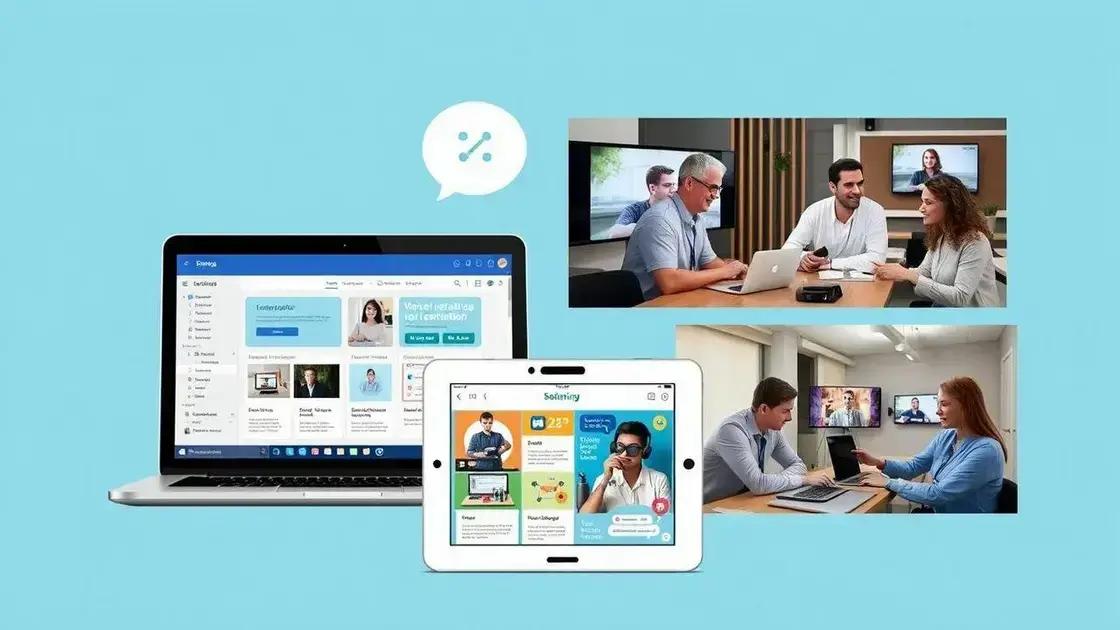E-learning tools: powerful methods to enhance learning

Anúncios
E-learning tools enhance education by using technologies like AI, VR, and interactive platforms, which provide personalized and immersive learning experiences for students, improving engagement and outcomes.
Have you ever wondered how e-learning tools could reshape your approach to education? With technology evolving, these tools can supercharge your learning experience. Let’s dive into their impact and benefits.
Anúncios
Understanding e-learning tools
Understanding e-learning tools is essential in today’s educational landscape. As technology advances, these tools are becoming vital for both teachers and students. They provide diverse ways to deliver content, helping to make learning more engaging.
What Are E-learning Tools?
E-learning tools are software applications or platforms designed to facilitate online learning. They can range from learning management systems (LMS) to interactive educational games. By using these tools, educators can create a more flexible and accessible learning environment.
Anúncios
Key Features of E-learning Tools
- Interactive Content: Engages students through quizzes and activities.
- Analytics and Reporting: Tracks student progress and performance effectively.
- Accessibility: Makes learning available from anywhere, at any time.
- Customization: Allows personalized learning paths for different students.
Moreover, many of these tools support a blend of visual and auditory learning styles, catering to various preferences among students. For example, platforms might include videos, podcasts, and infographics. This variety aids retention and motivation by addressing the diverse needs of learners.
As we explore further, it’s important to recognize that e-learning tools are not just limited to academic purposes. They are also valuable in corporate training and professional development. Companies implement them to train employees effectively while saving on time and resources.
In conclusion, understanding e-learning tools paves the way for enhanced educational experiences. These innovations are transforming how knowledge is shared and absorbed in both traditional and modern settings.
Benefits of e-learning tools for educators
Understanding the benefits of e-learning tools for educators can significantly impact their teaching methods. These tools provide innovative ways to enhance student engagement and improve learning outcomes.
Enhanced Flexibility
One major advantage is the flexibility they offer. Educators can deliver lessons at any time and from any location, making it easier to cater to diverse student schedules. This accommodates different learning paces and environments.
Improved Access to Resources
E-learning tools give educators access to a wealth of online resources. They can utilize videos, articles, and interactive simulations to enrich their lessons. This variety aids in keeping students interested and active in their learning, which is crucial for retaining information.
- Diverse Teaching Methods: Educators can implement various teaching strategies, from video lectures to gamified learning experiences.
- Streamlined Communication: Many platforms allow real-time communication between teachers and students, fostering better collaboration.
- Personalized Learning: Tools can adapt to individual student needs, ensuring everyone receives the attention they require.
- Cost-effective Solutions: E-learning reduces the need for physical materials, saving time and resources.
Moreover, these tools enable educators to track student performance through analytics. This data helps them identify students who may need additional support, allowing for timely interventions. By utilizing e-learning tools, teachers can fine-tune their approaches based on these insights.
Additionally, they can assist educators in connecting with a broader community of instructors. Sharing strategies, resources, and experiences through online forums boosts professional development. This collaborative environment promotes a shared growth mindset among teachers.
In essence, the benefits of e-learning tools for educators not only streamline educational processes but also create a more dynamic learning atmosphere, leading to enhanced educational experiences for students.
Types of e-learning tools available

Exploring the types of e-learning tools available can greatly enhance the educational experience for both teachers and students. These tools come in various forms, each designed to meet different needs in the learning process.
Learning Management Systems (LMS)
One popular type is the Learning Management System (LMS). An LMS allows educators to create, manage, and deliver their courses online. These systems often include features like course tracking, quizzes, and forums, providing a comprehensive platform for managing online education.
Interactive Content Tools
Another category includes interactive content tools, which engage students through games, quizzes, and simulations. This kind of interactive learning makes it easier for students to grasp complex concepts. Popular tools in this area often include interactive whiteboards and gamified learning platforms.
- Video Conferencing Tools: Applications like Zoom and Google Meet enable live teaching and real-time interaction.
- Collaborative Tools: Tools like Google Docs or Microsoft Teams facilitate teamwork and communication, allowing students to work together seamlessly.
- Assessment Tools: Platforms like Kahoot! or Quizlet are great for creating quizzes and tests that help evaluate student understanding.
- Content Creation Tools: These tools, such as Canva and Prezi, assist educators in creating attractive and informative lessons.
Additionally, many e-learning tools incorporate analytics features that help educators track student progress and engagement. Data analysis offers insights into which areas need improvement, enabling tailored educational experiences. By selecting the right types of e-learning tools, educators can ensure that they meet the specific needs of their students.
Furthermore, many of these tools are accessible from various devices, promoting flexibility in learning environments. Whether a student is at home or in a café, they can access learning materials anytime, anywhere. This level of accessibility is a significant factor in the growing popularity of e-learning tools.
Effective ways to integrate e-learning tools in teaching
Integrating e-learning tools effectively into teaching can enhance the learning experience significantly. These tools can transform traditional classrooms into dynamic learning environments that engage students more deeply.
Blended Learning Approach
One effective method is the blended learning approach. This combines traditional face-to-face instruction with online learning components. For instance, educators can deliver lectures in class while assigning interactive modules online. This way, students receive direct support and enjoy the benefits of online resources.
Utilizing Multimedia Resources
Another way to integrate e-learning tools is by using multimedia resources. Incorporating videos, podcasts, and interactive activities can address various learning styles. Visual elements like infographics can help simplify complex topics. Both teachers and students can benefit from access to a range of media that reinforces learning objectives.
- Interactive Forums: Create online discussion boards or forums where students can engage, debate, and share thoughts on specific topics.
- Regular Assessments: Use tools for quizzes and assessments to gauge understanding and provide immediate feedback.
- Collaborative Projects: Encourage group projects using platforms like Google Docs or Trello, enabling teamwork and enhancing communication skills.
- Gamification: Implement game elements in lessons through platforms like Kahoot! to make learning fun and engaging.
Additionally, teachers should encourage student ownership of learning by allowing them to choose topics or projects that interest them. This can foster a sense of independence and motivation. Furthermore, leveraging analytics from e-learning platforms can help educators identify struggling students and adjust their strategies accordingly.
Fostering a culture of collaboration among peers can also enhance engagement. Students can learn from each other through group activities and discussions. This not only strengthens their understanding but also builds essential social skills.
Future trends in e-learning tools
The future of e-learning tools is exciting and full of potential. As technology continues to evolve, we can expect to see transformative trends that will shape the way education is delivered and experienced.
Increased Use of Artificial Intelligence
One significant trend is the increased integration of artificial intelligence (AI) in e-learning tools. AI can personalize learning experiences by analyzing student data and adapting content to meet individual needs. This can help educators offer tailored instruction, allowing students to learn at their own pace.
Virtual and Augmented Reality
Another emerging trend is the use of virtual reality (VR) and augmented reality (AR). These technologies create immersive learning environments that engage students in ways traditional methods cannot. Imagine students exploring ancient civilizations through VR or practicing science experiments in a virtual lab.
- Mobile Learning: With the rise of smartphones, mobile learning will become even more prevalent, allowing students to access materials anytime, anywhere.
- Microlearning: Short, focused learning segments will gain popularity. This approach helps enhance retention by breaking down complex information into manageable lessons.
- Gamification: More educational platforms will incorporate gamification elements to motivate students and make learning more enjoyable.
- Data-Driven Insights: Advanced analytics will provide educators with real-time feedback on student engagement, helping them refine their teaching strategies.
Furthermore, as the demand for online education grows, we can expect more collaborative tools that facilitate peer learning and interaction. Platforms that support group projects, discussions, and other interactive features will become essential in fostering community among students.
Finally, the push for inclusivity will drive the development of e-learning tools designed to support diverse learners. Accessibility features and resources tailored for different learning styles will become standard in educational technology.
The future of e-learning tools presents numerous opportunities for enhancing education. As we embrace technologies like AI, VR, and data analytics, educators can better meet students’ needs. By staying aware of these trends, teachers can improve how they teach and how students learn. The importance of adaptive, interactive, and accessible e-learning tools cannot be overstated. Embracing these changes ensures that education remains engaging and relevant in an ever-evolving digital landscape.
FAQ – Frequently Asked Questions about E-learning Tools
What are e-learning tools?
E-learning tools are software applications that facilitate online education, offering features like quizzes, interactive content, and course management.
How can AI enhance e-learning platforms?
AI can personalize learning experiences by analyzing student behavior and adapting content to meet individual needs, improving overall engagement.
What benefits do VR and AR provide in education?
VR and AR create immersive environments, helping students experience learning in a more engaging and interactive way, which can enhance understanding.
Why is mobile learning important?
Mobile learning allows students to access educational materials anytime and anywhere, increasing flexibility and promoting continuous learning.






